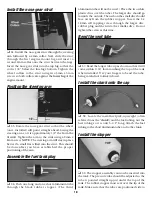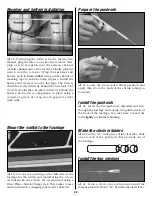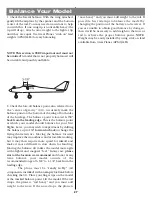
Dihedral
– The V shaped bend
in the wing. Typically more
dihedral causes more aerody-
namic stability in an airplane,
and causes the
rudder
to con-
trol both the
roll and yaw axis.
This is why some
trainers
and
sailplanes
require only 3 chan-
nels of radio control—i.e., hav-
ing no
ailerons.
Electric Starter
– A hand held,
electric motor used for starting
a model airplane engine.
Elevator
– Hinged control sur-
face located at the trailing edge
of the horizontal
stabilizer
,
which provides control of the
airplane about the
pitch axis
and causes the airplane to
climb or dive. The correct direc-
tion of control is to pull the
transmitter elevator control
stick back, toward the bottom of
the transmitter, to move the
elevator upward, which causes
the airplane to climb and vice
versa to dive.
Elevon
– Control surfaces used
on a flying wing or
Delta wing
type airplanes, located at the
trailing edge of the wing like
ailerons. Elevons move both up
or down together to control the
pitch axis
like an
elevator,
and
move differentially to control
the
roll axis
like
ailerons.
Elevons require either a
mechanical or electronic chan-
nel mixer.
Engine
– The source of thrust of
an airplane.
Expanded Scale Voltmeter (ESV)
- Device used to read the battery
voltage of the on board battery
pack or transmitter battery pack.
Flaps
– Hinged control surface
located at the trailing edge of the
wing inboard of the
ailerons
.
The flaps are lowered to produce
more aerodynamic lift from the
wing, allowing a slower takeoff
and landing speed. Maneuvering
flaps move up and down in con-
junction with the
elevator
, and
enhance the pitch control of the
airplane. This is used on some
aerobatic type of models, and
requires a mechanical or elec-
tronics channel mixer. Note:
Flaps and Maneuvering Flaps
are advanced features and are
not necessary or recommended
on
trainer aircraft.
Flaperon
– Control Surfaces on a
standard type airplane, located
at the trailing edge of the wing,
which function as
ailerons
by
moving differentially, and as
flaps by moving up or down
together. Flaperons require
either a mechanical or electronic
channel mixer. Note: Flaperons
are an advanced feature and are
not recommended on
trainer
aircraft.
Flight Box
– A special box used
to hold and transport all equip-
ment used at the flying field.
Flight Pack
– or Airborne pack.
All of the radio equipment
installed in the airplane, i.e.,
Receiver
,
Servos
, Battery,
Switch harness
.
Foam Rubber
– A soft foam
material used to wrap the
receiver and airborne battery for
vibration dampening in the
airplane.
Fuel Over Flow Line (Vent)
– The
fuel line which is either open to
atmospheric pressure or attaches
to the muffler pressure nipple, to
pressurize the fuel tank for bet-
ter fuel flow to the engine. This is
the line through which the fuel
will overflow when the tank is
full.
Fuel Pick Up Line
– The fuel line
in the fuel tank through which
the fuel travels to the
carburetor
. Typically a flexible
tube with a weight or "Clunk"
on the end which allows it to fol-
low the fuel with changes in air-
craft altitude. This is the line
through which the tank is filled.
Fuel Tank
– The container
which holds the fuel in an air-
plane.
Fuselage
– The body of an air-
plane
Fun Fly Airplane
– A specialty
model designed to be very light-
weight and perform very tight,
rapid, maneuvers such as loops
and rolls.
Glow Plug Clip/Battery
– A 1.2
volt battery, which is connected
to the glow plug on a model air-
plane engine for starting. The
battery is removed once the
engine is running steadily.
High Wing
– An airplane with
the wing mounted on top of the
fuselage
.
Hinge
– A flexible or hinged blade
which is glued into a control sur-
face and trailing edge to allow con-
trol surface deflection or move-
ment. Note: It is extremely impor-
tant that all hinges are permanent-
ly glued into both the control sur-
face and trailing edge. Improper
gluing will cause a crash.
32
Words shown in italics are defined elsewhere in this glossary.





































